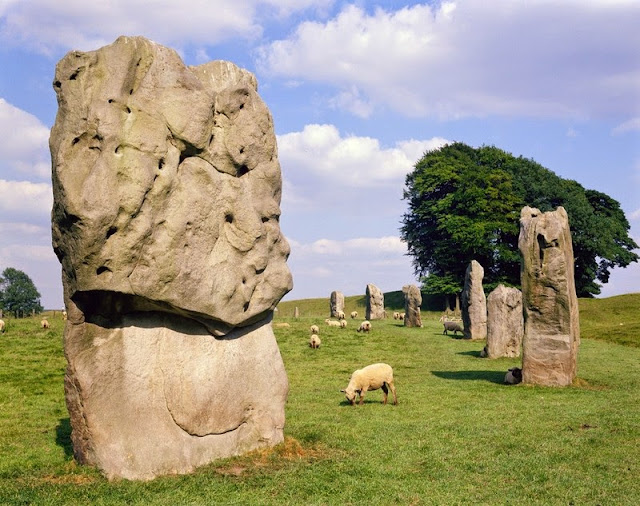Standing stones and burial chambers, geoarchaeology
Standing Stones of Stenness, south-east end of Loch of Stenness. Orkney. The henge and stone circle have radiocarbon dates suggesting that Stenness was constructed during the 3rd. millennium B.C. Four thin, unshaped flagstones now survive, the tallest over five metres high; it is thought that there were originally twelve stones set in a circle about 30 metres in diameter. Ploughing has almost levelled the henge earthworks but the circle once stood within a ditch and bank, with an entrance causeway to the north. The henge and stone circle of Stenness together with the Ring of Brodgar and associated outlying stones and burial mounds form part of a great ceremonial complex in the heart of Orkney, comparable to Callanish on Lewis in the Western Isles and to Stonehenge on Salisbury Plain in Wiltshire.
Dwarfie Stane, north-west Hoy, Orkney. The Dwarfie Stane is a neolithic burial chamber hollowed out from a solid block of cross-bedded Hoy Sandstone (Upper Old Red Sandstone). It is thought that the Dwarfie Stane is derived from cliffs on the downthrow side of the Bring Fault where massive beds of yellow or more rarely red sandstones of the Hoy Sandstone are found (the escarpment in the background).
Avebury stone circles, Wiltshire. Avebury is the largest 'henge' or stone circle in Britain.The standing stones of the Avebury circles, which range from 0.5 m. to 6 m. in height and number over 150 in total, are pale grey, silica-cemented sandstones of Tertiary age commonly known as sarsen stones. The source of the sarsen stone used in the megalithic site at Avebury is believed to be the Marlborough Downs. The stones were formed by the cementation of loose sands in the remnants of the Tertiary succession that once covered the downs. Some of the stones were revealed by weathering but others were probably dug from the succession and transported to Avebury. Sarsen stones are widely used in southern Britain at prehistoric sites including Avebury, Long Kennet and Stonehenge. Although best known as standing stones the sandstones were once extensively quarried on the Marlborough Downs for building stone. However, many standing stones are also believed to have been removed from the prehistoric structures for building purposes in earlier times.
Wayland's Smithy long barrow, Berkshire. Looking north. The Chalk downland area known as the Ridgeway, forming the southern edge of the Vale of the White Horse, is one of several areas littered with sarsen sandstone blocks. The sandstones are the remnants of a former Tertiary sedimentary cover and in some areas may be very abundant as at Clatford Bottom. Wayland's Smithy, named after the Saxon god of metalworking, is a neolithic long barrow constructed of silica-cemented, sandstone blocks known as sarsen stones or sometimes greywethers.
See also Stonehenge on BGS Geoheritage
Posted by Bob McIntosh








No comments:
Post a Comment